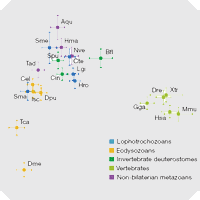Research Focus |
|
从三个冠轮动物水蛭、海蠕虫和青贝基因组解析两侧对称物种进化 2013-01-05 19:26:22 浏览次数:3128 | |
| 从三个冠轮动物水蛭、海蠕虫和青贝基因组解析两侧对称物种进化 来源:仪方生物 www.yeslab.com 目前的动物多样性基因组研究忽略了两个重要常见的软体动物和环节动物门,二者约占已知海洋物种的三分之一,并且是重要的生态学和古典胚胎学实验系统中的重要部分。研究组描绘了水蛭(leech)、海蠕虫(Capitella teleta)和青贝(limpet)基因组并通过相互比较探究双侧对称动物的起源和多样性。研究发现这相对于已测序的原口类(ematodes和扁虫)些物种的基因组组构、基因结构和功能与无脊椎动物的后口动物(例如文昌鱼和海胆)基因组更接近。这些基因组特性保守区有助于理清存在于最后的共同双侧对称物种的祖先中的基因,利用多重基因组特征建立双侧对称动物的三方多样性,在后生动物中鉴定早期保守的长和短遗传连锁位点。综合这些大量保守双侧对称动物信息,研究发现种系特异基因组进化例子,包括重组变化率、内含子获得和丢失、基因家族扩展和收缩,以及产生各自基因组特异内容的分支特异基因进化情况。 Insights into bilaterian evolution from three spiralian genomes Oleg Simakov, Ferdinand Marletaz, Sung-Jin Cho, Eric Edsinger-Gonzales, Paul Havlak,Uffe Hellsten, Dian-Han Kuo, Tomas Larsson, Jie Lv, Detlev Arendt, Robert Savage,Kazutoyo Osoegawa, Pieter de Jong, Jane Grimwood, Jarrod A. Chapman, Harris Shapiro,Andrea Aerts, Robert P. Otillar, Astrid Y. Terry, Jeffrey L. Boore, Igor V. Grigoriev, David R. Lindberg, Elaine C. Seaver, David A. Weisblat, Nicholas H. Putnam & Daniel S. Rokhsar Current genomic perspectives on animal diversity neglect two prominent phyla, the molluscs and annelids, that together account for nearly one-third of known marine species and are important both ecologically and as experimental systems in classical embryology. Here we describe the draft genomes of the owl limpet (Lottia gigantea), a marine polychaete (Capitella teleta) and a freshwater leech (Helobdella robusta), and compare them with other animal genomes to investigate the origin and diversification of bilaterians from a genomic perspective. We find that the genome organization, gene structure and functional content of these species are more similar to those of some invertebrate deuterostome genomes (for example, amphioxus and sea urchin) than those of other protostomes that have been sequenced to date (flies, nematodes and flatworms). The conservation of these genomic features enables us to expand the inventory of genes present in the last common bilaterian ancestor, establish the tripartite diversification of bilaterians using multiple genomic characteristics and identify ancient conserved long- and short-range genetic linkages across metazoans. Superimposed on this broadly conserved pan-bilaterian background we find examples of lineage-specific genome evolution, including varying rates of rearrangement, intron gain and loss, expansions and contractions of gene families, and the evolution of clade-specific genes that produce the unique content of each genome. |
